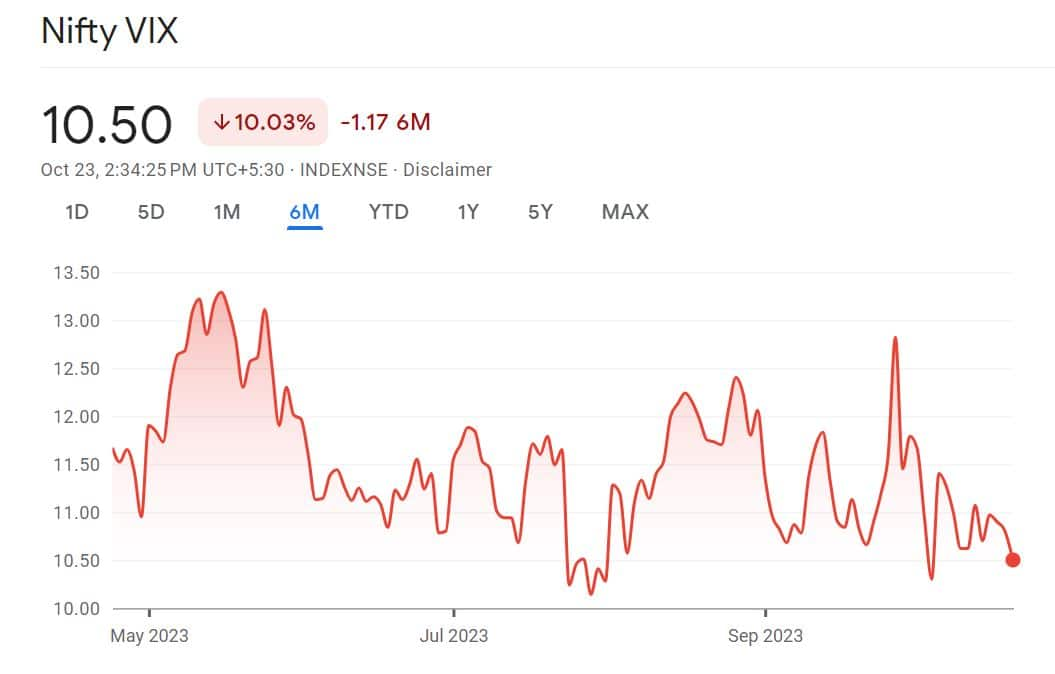VIX dips below 10 indicating Indian market is unfazed by global risks, traders puzzled


India VIX is as the expected annual change in the index over a 30-day period.
The India VIX, which measures the expected volatility for the next 30 days in the Nifty50, experienced a sharp decline today, dropping by approximately 6 percent and falling below 10.
Traders are puzzled by this trend because markets globally are under pressure and Indian shares too have fallen of late.
A rising VIX indicates that market participants are expecting volatility to increase in the days ahead whereas a low VIX means traders expect less volatility.
In a world marked by escalating geopolitical tensions, rising bond yields, and increasing crude oil prices, risk-on sentiments have been dampened globally. Despite these elevated risks, the VIX, which is displaying levels below 10, suggests that the markets are not perceiving these risks as significant.
A low VIX spells bad news for option writers. That is because the premium on options is lower if traders expect the market to be less volatile.
A simple way to understand India VIX is the expected annual change in the index over a 30-day period. For instance, if the India VIX currently stands at 11, it indicates that traders expect an 11 percent volatility for the upcoming 30 days.
This raises questions about the reliability of the VIX as an indicator of risk and what a VIX level of 10 signifies for the Indian markets. Here’s what analysts have to say:

Arun Kumar Mantri, Founder of Mantri Finmart, stated, “A lower VIX level typically implies that the market has a clear outlook on the index price movement, expecting lower volatility within a range that can be on either side of the current price. With the current INDIAVIX level around 10, if volatility increases, we may witness both volatile movements and a potential bearish trend in the index, especially since this is the monthly expiry, and there’s a trading holiday tomorrow.”
He further stated that a reading of INDIAVIX below 10 suggests that the index is currently experiencing minimal volatility. However, if the VIX gradually rises towards the 13-14 range in line with the current market trend, increased volatility may be witnessed in the upcoming days.
Chandan Taparia, Head of Derivatives at Motilal Oswal Financial Services, noted, “VIX has been lower for the past couple of months, and there is a negative correlation of 80-87 percent between volatility and the market. Lower volatility suggests that the market does not anticipate significant price swings. Despite FII selling and geopolitical tensions in some countries, the Indian market seems relatively unfazed by major global or domestic threats.”
He also highlighted that the India VIX typically tracks the trajectory of the US Cboe VIX, and at the moment, both are exhibiting a period of consolidation. As a result, significant market fluctuations or additional declines are not expected.
“The volatility of the index has decreased due to daily expiry, and traders are now taking hedged weekly positions with fewer positions. While India VIX is a valuable indicator that I closely monitor, it should not be disregarded. We should exercise caution only if the VIX surpasses levels of 13-14,” said Taparia.
He further explained that option traders who hold directional perspectives encounter a challenge in the form of reduced option premiums and diminished returns on their trades, primarily driven by the lower VIX. “To generate yield, they must sell nearby strikes, which leaves their positions vulnerable to even minor market movements. Currently, the market is favorable for traders who employ systematic hedged strategies,” he stated.
Disclaimer: The views and investment tips expressed by investment experts on Moneycontrol are their own and not those of the website or its management. Moneycontrol advises users to check with certified experts before taking any investment decisions.









